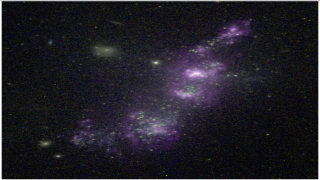Bibcode
Tenorio-Tagle, G.; Silich, Sergiy; Martínez-González, Sergio; Muñoz-Tuñón, C.; Palouš, Jan; Wünsch, Richard
Bibliographical reference
The Astrophysical Journal, Volume 778, Issue 2, article id. 159, 6 pp. (2013).
Advertised on:
12
2013
Journal
Citations
16
Refereed citations
16
Description
Following the observational and theoretical evidence that points at
core-collapse supernovae (SNe) as major producers of dust, here we
calculate the hydrodynamics of the matter reinserted within young and
massive super stellar clusters under the assumption of gas and dust
radiative cooling. The large SN rate expected in massive clusters allows
for a continuous replenishment of dust immersed in the high temperature
thermalized reinserted matter and warrants a stationary presence of dust
within the cluster volume during the type II SN era. We first show that
such a balance determines the range of the dust-to-gas-mass ratio, and
thus the dust cooling law. We then search for the critical line that
separates stationary cluster winds from the bimodal cases in the cluster
mechanical luminosity (or cluster mass) versus cluster size parameter
space. In the latter, strong radiative cooling reduces considerably the
cluster wind mechanical energy output and affects particularly the
cluster central regions, leading to frequent thermal instabilities that
diminish the pressure and inhibit the exit of the reinserted matter.
Instead, matter accumulates there and is expected to eventually lead to
gravitational instabilities and to further stellar formation with the
matter reinserted by former massive stars. The main outcome of the
calculations is that the critical line is almost two orders of magnitude
or more, depending on the assumed value of V A∞, lower
than when only gas radiative cooling is applied. And thus, many massive
clusters are predicted to enter the bimodal regime.
Related projects

Starbursts in Galaxies GEFE
Starsbursts play a key role in the cosmic evolution of galaxies, and thus in the star formation (SF) history of the universe, the production of metals, and the feedback coupling galaxies with the cosmic web. Extreme SF conditions prevail early on during the formation of the first stars and galaxies, therefore, the starburst phenomenon constitutes a
Casiana
Muñoz Tuñón